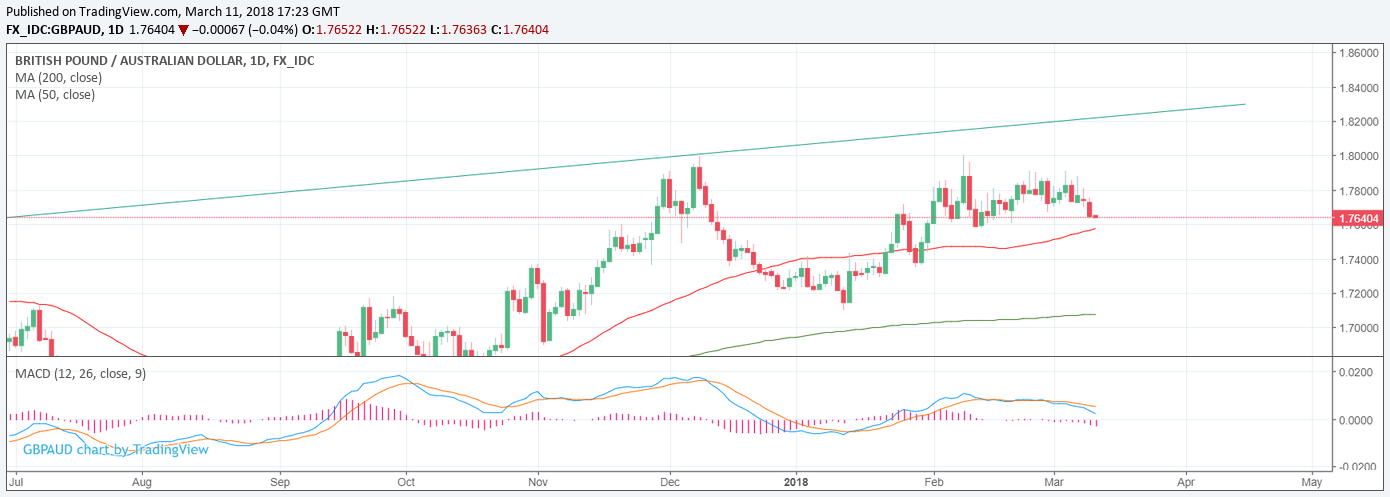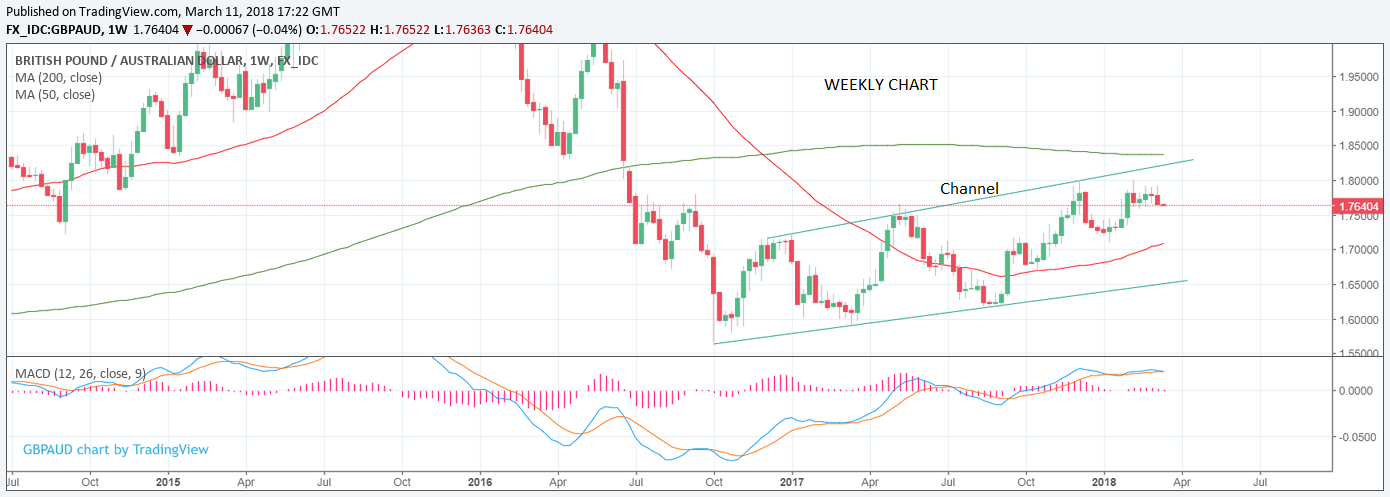Pound-to-Australian Dollar Rate Forecast for the Week Ahead

© kasto, Adobe Stock
Sterling continues to trade with a bullish bias against the Australian Dollar and we eye the next potential targets.
The GBP/AUD exchange rate is quoted at 1.7604 in early European trade on Monday, March 12 with the Australian Dollar having strengthened during the Asian session, extending the boost granted late on Friday which came courtesy of the broadly softer USD that followed the release of softer-than-forecast wage data out of the US.
The Trump administration meanwhile granted Australia exemption from US steel and aluminium tariffs.
"Australia runs a trade deficit with the U.S. which probably assisted the case for an exemption. Australia joins Canada and Mexico with exemptions from these particular tariffs (pending the renegotiation of NAFTA). Chinese February economic data will likely be soft and affected by the timing of Chinese New Year when it is released later this week. We anticipate AUD to remain within recent ranges," says Richard Grace, an analyst with CBA in Sydney.
We note that GBP/AUD has been trading sideways over the last week but there is a possibility of further gains as the overall long-term trend remains up.
The pair has been rising steadily in a channel since the October 2016 low and the broad uptrend is intact and expected to bias the exchange rate to continue rising in the future.
If GBP/AUD breaks above the 1.8000 February highs we would expect an extension up to an initial target at 1.8200, at the level of the upper channel borderline.
At that level, it might encounter heavy selling, however, and see a pull-back or even reversal back down again.

Data and Events to Watch for the Australian Dollar
The main event in the week ahead is commentary from Reserve Bank of Australia (RBA) assistant governor Christopher Kent and deputy governor Guy Debelle on Tuesday and Thursday at 10.05 and 10.45 GMT respectively.
"Looking ahead, RBA comments are the main focus for AUD," says Kathy Lien, Managing Director at BK Asset Managment, adding "technically, higher highs and higher lows point to further gains for AUD/USD, which should at minimum hit 79 cents."
Despite an officially neutral stance, the governor of the RBA Philip Lowe was unexpectedly upbeat when he last spoke, saying he thought the next move from the RBA would be to raise interest rates rather than to cut them. Analysts will be closely scrutinizing the commentary from his lieutenants in the week ahead to try to ascertain whether they are as hawkish as he is. If so then AUD is likely to climb even higher.
AUD is a 'risk-on' currency which means it gains when risk appetite rises. This probably explains why it rose so strongly after Chinese inflation data last week, showed higher-than-expected inflation, and indicated to markets that the global reflationary trend was starting again.
On the hard data front, the coming week sees the release of NAB Consumer Confidence on Tuesday at 00.30 GMT which is forecast to show a rise of 9 in February from 12 previously.
Consumer confidence gauges from Westpac are also released at the same time.
Data and Events to Watch for the Pound
The main event for the Pound in the week ahead is probably the Chancellors’ Spring Statement, this is a new initiative brought in by Philip Hammond to provide an update on the economic and fiscal outlook.
No changes to the budget are expected and the statement is only scheduled to last 15-20mins, according to media reports, which is only a rump compared to the Autumn statement.
Budget's do not often move currencies so the Pound may not react, however, alongside the statement are revised forecasts from the Office of Budgetary Responsibility (OBR) which if substantially altered may impact on growth prospects and therefore Sterling.
The OBR has, on balance, been overly pessimistic in the past, generally undershooting with its forecasts and leading some commentators to expect it to revise up its forecasts on Tuesday.
"It is always difficult to predict other institutions’ forecasts. However in terms of the Spring Statement, we would expect the GDP growth projections to be a little more upbeat," says Ryan Djajasaputra, an analyst at Investec.
The OBR's most recent forecasts are contained in the table below.
For the sake of context, Investec's own house forecasts is for GDP growth of 1.7% in each year.
The other main event is the Bank of England's (BOE) Financial Policy Committee (FPC) meeting on Monday (statement published Friday 16) to discuss possible changes to capital buffers, introduced after the financial crisis under the Basel 3 regulatory framework.
The focus will be on whether the BOE reviews the size of the "Counter Cyclical Capital Buffer" (CCYB), a piece of regulation which guards against excessive bank-lending during upturns and excessive parsimony during downturns - thus the "counter-cyclical" sobriquet.
In November it was raised to 1%, with the FPC also indicating that it could be increased further in H1 2018 - so there is a possibility of a change at the meeting.
Again, this is unlikely to hit FX markets in any major way, and even if it does the impact may be difficult to gauge beforehand.
The CCYB impacts on the supply of credit, and therefore on inflation and growth, which in turn influence currency value, and it will probably form a part of the bigger picture that currency analysts consider in relation to their forecasts.
Generally increases in the supply of credit are seen as inflationary and likely to increase interest rates, which in turn leads to capital accumulation and a stronger currency.
Get up to 5% more foreign exchange by using a specialist provider to get closer to the real market rate and avoid the gaping spreads charged by your bank when providing currency. Learn more here.





